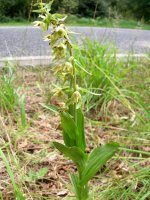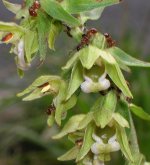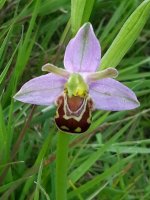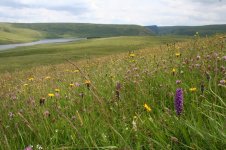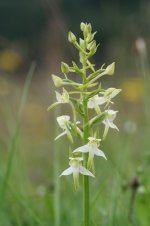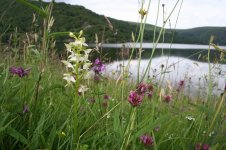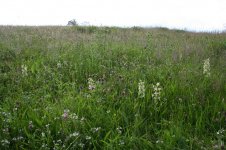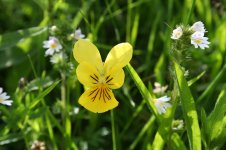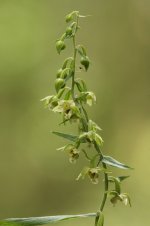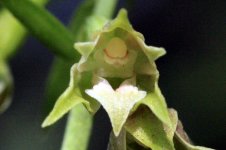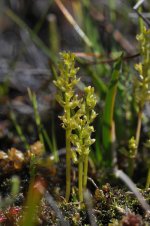-
Welcome to BirdForum, the internet's largest birding community with thousands of members from all over the world. The forums are dedicated to wild birds, birding, binoculars and equipment and all that goes with it.
Please register for an account to take part in the discussions in the forum, post your pictures in the gallery and more.
You are using an out of date browser. It may not display this or other websites correctly.
You should upgrade or use an alternative browser.
You should upgrade or use an alternative browser.
2012 UK Orchid season updates (15 Viewers)
- Thread starter heakl
- Start date
More options
Who Replied?rmielcarek
Well-known member
Second site had a putative hybrid Broad-leaved x Green-flowered helleborine in 2010, which was eaten off before it could flower in 2011. Where there were c70 GFH two years ago, this year there were none - just a single Broad-leaved. More evidence of a poor Epipactis year.
That reminds me of a Helleborine that I photographed six years ago and identified as Green-flowered but it's bugged me ever since. It was at a site where there are Broad-leaved and a few Green-flowered of the type where the buds only open slightly or not at all.
I've got this thing, which was growing in a storm gutter by the side of a busy road, down as a pendula GFH but I often look at it and have my doubts.
Anyone any views?
Rich M
Attachments
leptochila
Well-known member
That reminds me of a Helleborine that I photographed six years ago and identified as Green-flowered but it's bugged me ever since. It was at a site where there are Broad-leaved and a few Green-flowered of the type where the buds only open slightly or not at all.
I've got this thing, which was growing in a storm gutter by the side of a busy road, down as a pendula GFH but I often look at it and have my doubts.
Anyone any views?
Rich M
The close together spirally ranked leaves up the length of the stem and open flowers certainly look good for helleborine influence in my mind.
Mike.
That reminds me of a Helleborine that I photographed six years ago and identified as Green-flowered but it's bugged me ever since. It was at a site where there are Broad-leaved and a few Green-flowered of the type where the buds only open slightly or not at all.
I've got this thing, which was growing in a storm gutter by the side of a busy road, down as a pendula GFH but I often look at it and have my doubts.
Anyone any views?
Rich M
Knowing where it was taken would perhaps help, if its Cotswolds or further south I'd take a stab at viridiflora.
I'm north of Liverpool at the moment and the green-flowered here are a little more like your photo than the southern ones.
Some of the dune helleborine here are still good but many are past it, the early marsh have nearly had it,just the odd one still fresh. Marsh helleborine by the thousand.
Alan
rmielcarek
Well-known member
Knowing where it was taken would perhaps help, if its Cotswolds or further south I'd take a stab at viridiflora.
Alan
It's in either north Hants or Berks, I'm not sure which.
I've only seen BLH viridiflora a couple of times and the whole plant seemed to be a uniform green, not the contrasting yellowish sepals/petals on this plant.
I've seen GFH pendula in the Cotswolds and in Cumbria but the flowers always seem to hang down (pendulous) close to the stem whereas in this plant they seem to stick out from the stem.
Whenever I look at it I get features that suggest BLH and others that suggest GFH.
Rich
Ghostly Vision
Well-known member
Hi Rich
Was it self-pollinated or cross-pollinated? Can't tell from the pics.
Apart from the angle of the flowers, what concerns you about its purity as phyllanthes?
these things always look more different in the field than in photos.
The hybrid I was talking about is in Hants, but definitely not your plant or site.
Perhaps you could email me the location so I can comment off the public forum?
I have a copy of an article somehwere on the occurrence of a "proven" hybrid of this pair in Denmark. I'll look it out (will be after the weekend) and send it to you.
Cheers
Sean
Was it self-pollinated or cross-pollinated? Can't tell from the pics.
Apart from the angle of the flowers, what concerns you about its purity as phyllanthes?
these things always look more different in the field than in photos.
The hybrid I was talking about is in Hants, but definitely not your plant or site.
Perhaps you could email me the location so I can comment off the public forum?
I have a copy of an article somehwere on the occurrence of a "proven" hybrid of this pair in Denmark. I'll look it out (will be after the weekend) and send it to you.
Cheers
Sean
davidearlgray
davidearlgray
Whenever I look at it I get features that suggest BLH and others that suggest GFH.
Looking at the photos I would agree with Alan.It looks like viridiflora to me.
Here is a couple of links for reference:
http://davidearlgray.blogspot.co.uk/2010/08/epipactis-in-lincolnshire-and.html
http://davidearlgray.blogspot.co.uk/2009/07/broad-leaved-helleborines-at-cloud-wood.html
Hope this helps?
Cheers,
Dave.
Looking at the photos I would agree with Alan.It looks like viridiflora to me.
Here is a couple of links for reference:
http://davidearlgray.blogspot.co.uk/2010/08/epipactis-in-lincolnshire-and.html
http://davidearlgray.blogspot.co.uk/2009/07/broad-leaved-helleborines-at-cloud-wood.html
Hope this helps?
Cheers,
Dave.
leptochila
Well-known member
Whenever I look at it I get features that suggest BLH and others that suggest GFH.
Looking at the photos I would agree with Alan.It looks like viridiflora to me.
Here is a couple of links for reference:
http://davidearlgray.blogspot.co.uk/2010/08/epipactis-in-lincolnshire-and.html
http://davidearlgray.blogspot.co.uk/2009/07/broad-leaved-helleborines-at-cloud-wood.html
Hope this helps?
Cheers,
Dave.
Hi Dave
I think we can be sure that Rich's plant is almost definitely a phyllanthes - the long pointed tepals and, (although not necessary a indicative to phyllanthes it is more a feature of that species) the drooping flowers with possible helleborine influence rather than the other way round.
I've seen the exact same viridflora (and indeed the exact same phyllanthes!) photographed on your blog and can confirm that it was clearly a helleborine in every way, bar the anthocyanin pigment - a little different to this plant which, as Rich notes, shows the yellowish petals contrasting with the sepals and maybe even a hint of pink on the lip. Rich's plant is in my mind more like phyllanthes with minor helleborine features.
Really need to see the pollination mechanism!
Mike.
Last edited:
rmielcarek
Well-known member
Is this really viridiflora, the inside of the hypochile is brown whereas it should be green? Plant in first link looks fine.
Rich
davidearlgray
davidearlgray
Hi Mike and Rich, the BL Helleborines at Cloud Wood are so variable I think you need to do a PhD on them to understand them!
I will hopefully photograph them again this week and will let you know what I find.
I have also spoken to Sean about these plants as there vary from your typical BL Hells to something which looks like Young's Helleborine!
On last year's count I found almost 200 plants in all shape and sizes.
Hope this helps?
Cheers,
Dave.
I will hopefully photograph them again this week and will let you know what I find.
I have also spoken to Sean about these plants as there vary from your typical BL Hells to something which looks like Young's Helleborine!
On last year's count I found almost 200 plants in all shape and sizes.
Hope this helps?
Cheers,
Dave.
Hi Dave
I think we can be sure that Rich's plant is almost definitely a phyllanthes - the long pointed tepals and, (although not necessary a indicative to phyllanthes it is more a feature of that species) the drooping flowers with possible helleborine influence rather than the other way round.
I've seen the exact same viridflora (and indeed the exact same phyllanthes!) photographed on your blog and can confirm that it was clearly a helleborine in every way, bar the anthocyanin pigment - a little different to this plant which, as Rich notes, shows the yellowish petals contrasting with the sepals and maybe even a hint of pink on the lip. Rich's plant is in my mind more like phyllanthes with minor helleborine features.
Really need to see the pollination mechanism!
Mike.
I think we might have to agree to differ on this one Mike, although I should add that I'm only looking at a 2" BlackBerry screen.
I see three pointers to BLH:-
Hairy ovaries
No groove between bosses (but yes, they do look clean!)
Ants, I often see them after the nectar on BLH but not on GFH
I'm happy to be proved wrong, or convinced so.
Alan
leptochila
Well-known member
I think we might have to agree to differ on this one Mike, although I should add that I'm only looking at a 2" BlackBerry screen.
I see three pointers to BLH:-
Hairy ovaries
No groove between bosses (but yes, they do look clean!)
Ants, I often see them after the nectar on BLH but not on GFH
I'm happy to be proved wrong, or convinced so.
Alan
Could always be a hybrid...why has no one suggested that
Mike.
leptochila
Well-known member
Elan Valley
The old upper fringe hay meadows of the Elan Valley have alluded me for long enough so I visited a couple today on my way through. First impressions were that these are very well managed; bursting with upland flora including quite a few orchids. The first gave spectacular views over Craig Coch Reservoir with Eyebright creating an understorey carpet, peppered with Southern Marsh orchids and the odd Common Spotted. The second meadow (managed by the wildlife trust) runs right down to the edge of Penygarreg Reservoir. This was possibly one of the most spectacular upland hay meadows I've ever seen (partly due to the setting). Around 80 Greater Butterfly orchids in full flower (many just opening!) accompanied by Heath Spotteds and a single Common Fragrant along with swathes of Mountain Pansy, Harebell, Bog Asphodel, Betony, Eyebright, Lesser Knapweed and Great Burnet.
Well worth a visit.
Mike.
(More photos on my Flickr photostream)
The old upper fringe hay meadows of the Elan Valley have alluded me for long enough so I visited a couple today on my way through. First impressions were that these are very well managed; bursting with upland flora including quite a few orchids. The first gave spectacular views over Craig Coch Reservoir with Eyebright creating an understorey carpet, peppered with Southern Marsh orchids and the odd Common Spotted. The second meadow (managed by the wildlife trust) runs right down to the edge of Penygarreg Reservoir. This was possibly one of the most spectacular upland hay meadows I've ever seen (partly due to the setting). Around 80 Greater Butterfly orchids in full flower (many just opening!) accompanied by Heath Spotteds and a single Common Fragrant along with swathes of Mountain Pansy, Harebell, Bog Asphodel, Betony, Eyebright, Lesser Knapweed and Great Burnet.
Well worth a visit.
Mike.
(More photos on my Flickr photostream)
Attachments
Last edited:
Ghostly Vision
Well-known member
Hi Mike and Rich, the BL Helleborines at Cloud Wood are so variable I think you need to do a PhD on them to understand them!
I will hopefully photograph them again this week and will let you know what I find.
I have also spoken to Sean about these plants as there vary from your typical BL Hells to something which looks like Young's Helleborine!
On last year's count I found almost 200 plants in all shape and sizes.
Hope this helps?
Cheers,
Dave.
Hi Dave/all,
Yes, I have seen the Cloud Wood plants a couple of times, and they do vary from the occasional quite dark-flowered ones, through to clear-cut viridiflora (I think actually more correctly known as chlorantha, unfortunately, to confuse matters). I do agree with Rich though, that the pic you posted as viridiflora/chlorantha from Cloud wood is not, as it contains some pink pigment on the lip, and has darker inner to the hypochile, as Rich points out.
Sean
Ghostly Vision
Well-known member
I think we might have to agree to differ on this one Mike, although I should add that I'm only looking at a 2" BlackBerry screen.
I see three pointers to BLH:-
Hairy ovaries
No groove between bosses (but yes, they do look clean!)
Ants, I often see them after the nectar on BLH but not on GFH
I'm happy to be proved wrong, or convinced so.
Alan
Hi Alan
Some extremely good points, and I am tending to agree with you....but with caveats.
I agree the lip looks helleborine-like in terms of the bosses. The ants are an excellent and novel pointer, too - I'll remember that one!
I do think the hairy ovaries might be an artefact created by camera shake in the close-up. I'm struggling to see that as a feature whilst viewing on my laptop.
Looking again at the close-up, it is clear that completely intact pollinia are visible on at least two flowers, one of which is otherwise almost gone over. This would go strongly against it being phyllanthes, and very much towards it being helleborine. I wonder if it also may indicate hybrid origin....perhaps any scent/colour attractive to wasps, that helleborine puts out, is confused and they have therefore avoided the plant? It is unusual in my experience to see a long-open E. helleborine which has not been visited at all by wasps.
The leaf structure looks better for helleborine, too.
I would be inclined towards this plant being viridiflora/chlorantha Broad-leaved helleborine, but with the possibility that it is indeed a hybrid (this would be the first proven record for England, and only the second for Europe that I know of, as it preceeds the Hampshire one which was found in 2010).
Rich - I know you have given me the site name, perhaps you could email me some more specific directions, as I am headed that way this week? I would be interested to check the site out. More pics and maybe send them to John Richards for an opinion? Mark Lynes would be interested, too, no doubt.
All the best
Sean
rmielcarek
Well-known member
Rich - I know you have given me the site name, perhaps you could email me some more specific directions, as I am headed that way this week? I would be interested to check the site out. More pics and maybe send them to John Richards for an opinion? Mark Lynes would be interested, too, no doubt.
Sean
Sean
I've emailed you. And I've asked Mark for an opinion.
And those are the only 2 photos I took.
Rich M
Hi all,
My initial thoughts on the plant Rich posted was that it looked jizz wise like a Green-flowered (colour, depiction of assumed leaf texture etc), but with a few anomolous features as pointed out already (eg the hairy ovaries - unless this is an artifact of the flash, very open flowers - ofcourse GFH can be very open, fairly defined pollinia, lack of swelling in ovaries). As also noted, the pics dont particularly allow you to see the presence/absence of a viscidium and structure of the Anther/cap and other reproductive parts. It sort of looks extended in profile (see illustrations in Delforge's guide for BLH, and Young's papers for GFH).
The 2010 plant Sean mentioned was growing on a road side with a population of 70 or so Green-flowered and a similar number of Broad-leaved in a good year. Jizz wise this plant looked quite Green-flowered on a casual view (yellowy-green and pendulous flowers mostly one sided), but in close up was clearly more of a Broad-leaved type - with functioning viscidium. Attached is a photo of the 2010 plant. Rich if you send me a pm with your email address I will email you a whole pdf of photos if you want.
Ive also attached a photo of a Green-flowered with sort of well defined pollinia and a weakish viscidium. This was a clear GFH in other respects, and the anther/cap as can be seen is squat sits forward and the reproductive parts are otherwise more like a typical GFH. You can see also on this flower the lip is starting to tend towards the disputed var degenera (and further on in variation, var phyllanthes - the peloric form), although it does have a very well defined 'cup', which is well demarcated from the lip, as per var vectensis.
My initial thoughts on the plant Rich posted was that it looked jizz wise like a Green-flowered (colour, depiction of assumed leaf texture etc), but with a few anomolous features as pointed out already (eg the hairy ovaries - unless this is an artifact of the flash, very open flowers - ofcourse GFH can be very open, fairly defined pollinia, lack of swelling in ovaries). As also noted, the pics dont particularly allow you to see the presence/absence of a viscidium and structure of the Anther/cap and other reproductive parts. It sort of looks extended in profile (see illustrations in Delforge's guide for BLH, and Young's papers for GFH).
The 2010 plant Sean mentioned was growing on a road side with a population of 70 or so Green-flowered and a similar number of Broad-leaved in a good year. Jizz wise this plant looked quite Green-flowered on a casual view (yellowy-green and pendulous flowers mostly one sided), but in close up was clearly more of a Broad-leaved type - with functioning viscidium. Attached is a photo of the 2010 plant. Rich if you send me a pm with your email address I will email you a whole pdf of photos if you want.
Ive also attached a photo of a Green-flowered with sort of well defined pollinia and a weakish viscidium. This was a clear GFH in other respects, and the anther/cap as can be seen is squat sits forward and the reproductive parts are otherwise more like a typical GFH. You can see also on this flower the lip is starting to tend towards the disputed var degenera (and further on in variation, var phyllanthes - the peloric form), although it does have a very well defined 'cup', which is well demarcated from the lip, as per var vectensis.
Attachments
Dave Pearson
Well-known member
lewis20126
Well-known member
I've not seen anything pollinating Bog Orchids at a small colony I know in the New Forest although have visited twice recently, but here is a BTO from Martin Down this year with attendant Fly which did a great deal of wandering over it. Anyone know their Diptera or similar?
cheers, alan
cheers, alan
Attachments
Users who are viewing this thread
Total: 16 (members: 0, guests: 16)




